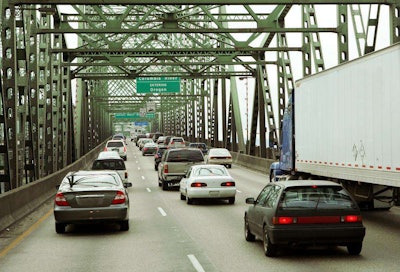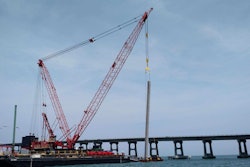
The report has been in the works for a year by a 35-member panel, and is intended to cover near-term recommendations and a “vision” for 30 years.
“It is the panel’s vision that in 30 years Oregon will have a transportation system in good repair, resilient to natural disasters, and financially stable,” says panel co-chair Gregg Kantor. “Oregon will have a safe, reliable, and efficient multimodal network that supports Oregon’s businesses and enhances Oregonians’ quality of life. But to get there, we must take immediate action.”
The recommendations from the report include:
Transportation maintenance
- Transportation system maintenance: Oregon’s top transportation investment priority must be to preserve and maintain existing transportation assets across all modes.
Roadway bottlenecks
- Invest in bottleneck elimination: Improve capacity and throughput of existing roadway bottlenecks on the highest priority corridors of statewide significance (I-5, I-205, etc.).
- Invest in freight network alternatives: Invest in improved capacity and efficiency of rural highway corridors (Highway 97, etc.) that create freight network alternatives.
- Transportation demand management strategies: Invest in transportation options and demand management strategies such as transit, rideshare, biking and walking, and employer incentives. Additionally, invest in freight enhancements (such as truck rest areas and port drop sites) that reduce roadway trucking demand during peak hours of congestion.
Transit
- Reduce gaps in transit service: Transit investments don’t always align with existing needs within communities or between communities. Future investments must aim to close both state and local gaps in service and enhance intercity transit connections to meet workforce and equity needs and help achieve greenhouse gas reduction goals.
- Maximize transit funds: Transit districts often leave federal funds “on the table” because they do not have adequate resources to provide a “local match.” New state and local investments in transit should maximize the potential for federal matching funds, as well as enhance the reliability and efficiency of transit services.
- Increase flexibility of K-12 student transportation services: Redefine student transportation to ensure that communities are meeting the changing needs of students across the state. Increase flexibility and improve efficiency in how school districts are able to spend transportation revenue, such as transit district partnerships.
Bike and pedestrian investments
- Reduce fatalities and injuries: Oregon must continue to prioritize and invest in bold efforts to dramatically reduce crashes that disproportionately cause fatalities and injuries for people walking and biking. Programs such as Safe Routes to School and investments in sidewalks and separated facilities are essential tools to reduce roadway conflicts and protect vulnerable users. New bicycle and pedestrian investments should also aim to maximize the potential for federal matching funds.
- Support economic opportunities for tourism/tours: In order to support recreational tourism, connections on bikeways, shoulders, and sidewalks should be completed to improve safety and close gaps. Consideration is also needed to educate visitors on how to best share narrow rural roadways, especially during harvest season.
Intermodal freight infrastructure
- Intermodal freight facilities: Identify and invest in intermodal facilities and freight connectors (e.g., transload facilities, port drop sites, inland ports, etc.) that reduce highway demand for freight.
- Create a permanent ConnectOregon fund: A permanent ConnectOregon fund for non-highway transportation assets would help the state coordinate and support strategic investments.
- Develop a statewide marine plan: Integrate and better link Oregon’s ports and marine transportation system through a system plan and investment strategy. This plan could better tie the marine system with the Freight Plan and other transportation modal plans; help determine statewide funding priorities that impact the marine system (e.g., road, rail, and waterway system improvements); address marine land use issues; and help organize shipper alternatives (e.g., barging of containers along the Columbia River).
Seismic resiliency
- Invest in seismic resiliency: Additional resources must be secured to adequately shore up seismic resiliency. This includes consideration in future state transportation investments and ongoing advocacy at the federal level for designations and funds to support this effort.
- Increase coordination with West Coast states: Strengthen coordination of planning efforts with California and Washington, and identify immediate investment needs for high priority transportation assets including I-5 and Highway 97 corridor improvements.
- Non-highway inventory assessments: Seismic planning for non-highway modes (e.g., aviation, marine, rail) to date has been piecemeal and inadequate. Tools should be provided for these transportation entities to perform thorough inventories and assess seismic vulnerabilities.
- Local seismic needs assessments: Many of Oregon’s local jurisdictions have not conducted assessments of transportation vulnerabilities and priorities because they do not have the necessary resources. Adequate resources should be dedicated to perform these assessments; and local transportation agencies should have the tools necessary to respond to a disaster.
Jurisdictional transfer
- Enact a jurisdictional transfer program: Implement a pilot program that includes up to five priority transfers where there is broad state and community support and dedicate revenue to achieve these transfers.
- Establish jurisdictional transfer working group: Create a working group that refines criteria for future transfers and streamlines the process.
Transportation innovation
- Expand innovation partnerships: Establish partnerships with companies and other states with the objective of making Oregon a key testbed for the development and deployment of innovative transportation technologies (e.g., connected and automated vehicles, electric vehicles, drones).
- Appoint a transportation innovation officer: Appoint a transportation innovation officer within the Governor’s Office to drive interagency coordination in support of transportation innovation.
Emissions measures
- Track carbon reduction impacts: To ensure policy efforts are making a difference in reducing emissions, and to prepare for potential new federal requirements, the state should consider creating an office that draws upon independent and private sector expertise to begin tracking and reporting on Oregon’s carbon reduction progress. The office should regularly report to the Governor’s Office and Legislature on progress made to meet the state’s carbon emission reduction goals.
Land use and transportation
- Land use and transportation policy assessment: A joint effort should be made by the Oregon Transportation Commission and the Land Conservation and Development Commission to ensure that our land use and transportation policies are well aligned and meet the needs of Oregon’s growing population.
The full report is available at https://visionpanel.wordpress.com.









